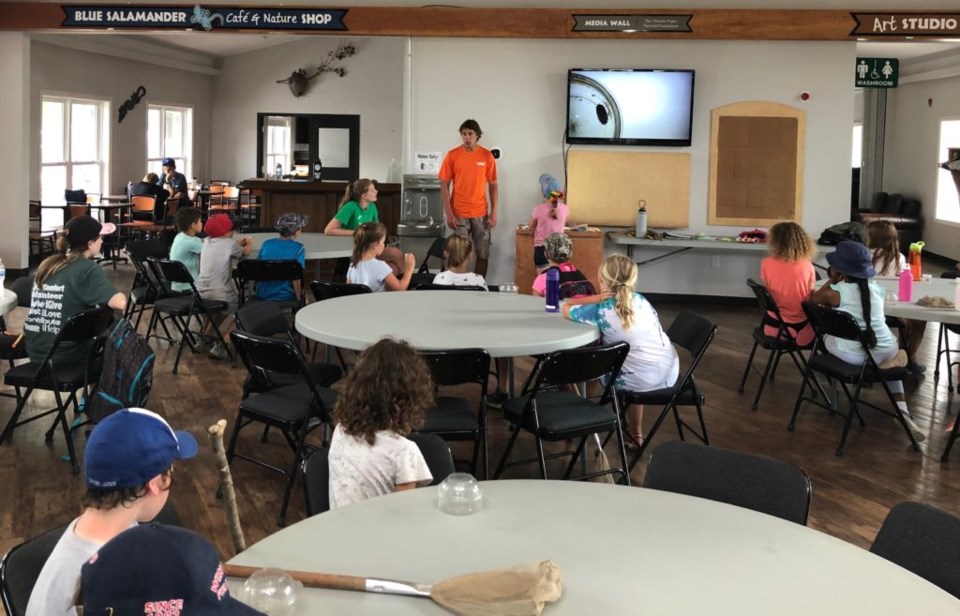
Halloween is coming up, so today’s article is seasonal and spooky.
It’s also harvest season in the Niagara region. That means we have a new wave of visitors coming into the region to soak up the beverages and nice weather. But did you know that vespidae are also coming into town more often, too?
Vespidae is a family of insects that includes some backyard familiarities such as yellow jackets, bald-faced hornets, and paper wasps, among 5,000 other species worldwide. Wasps are generally smaller and skinnier than their close relatives, the bulkier, more robust-looking hornets. All of the species present in NOTL nest in places such as a hole in the ground, in the shed, or perhaps the football-like hornet nest that hangs ominously in the tree.
I chose to write about these creatures because they appropriately make themselves known around this time of year approaching Halloween, and of course, they scare a lot of people.
A large part of my environmental work is dedicated to showcasing the smaller majority, the lesser-seen or lesser-appreciated living things that make our world operate smoothly. Insects are the most diverse grouping of living things on the planet. The ones we love and hate have the ability to dictate our economies and our very well-being. They do so by occupying vital roles in ecosystems around the globe. They eat, get eaten, pollinate, and sometimes get drunk and sting people by accident.
There are some winged friends and foes of ours that also enjoy harvest season. You’re walking down the street by a garbage can, and a single wasp gets distracted and bounces off you. And now you’re walking, and the insect can’t help but continue its delirious flight path, doing big, slow figure eights and then colliding with you again.
Between the sound of the wings and the fermenting fruit they’ve consumed, they are potentially “buzzed” in more ways than one.
It’s not just our grapes and tender fruit lying around on the soil that cause this phenomenon. It makes sense that both our agricultural crops and wild plants alike are dropping their fruits and leaves at this time of year. In deep, undisturbed natural areas around the world, wasps and bees will find the fruits, berries, and rotting plants to create such behaviours.
At this time of year, they become notably more present and even extra irritable. Imagine spending three months in an inebriated, irritated, cold slumber. Your body is also slowing down to over-winter, and now you’re trying to find somewhere to live after too many drinks. That’s a tall task, so let’s give them some credit.
Although I’m emphasizing the fermenting fruit and vespidae relationship (because it’s so intriguing and makes a good laugh), that is not the only reason these flying insects are dopey at this time of year. It is also getting colder, which slows their tiny insect bodies down substantially, and they are finalizing a location to tough out the winter as a colony.
My work at Heartland Forest in Niagara Falls involves all things outdoors, and there is an element of the public visiting at the same time. In the past month or so, we’ve discovered five substantial wasp nests that would have been dangerous if accidentally disturbed. I always feel bad when I remove the nests, considering all the hard work these complex colonies have put together to create them, but public safety comes first. It’s another example of our complex relationship with wasps and their relatives.
Thankfully my eyes have become pretty sharpened over the years, and I can spot ground nests in the forests readily. The forest is full of dancing particles of dust and bugs in the light, but the rest of it can be impossibly still. That’s when you notice a funnel of little dots going in and out at one location. There’s the nest, and hopefully it’s off-trail and can be left in peace where it isn’t dangerous.
Despite vespidae’s ongoing presence, we need them.
They predate scores of other insects and keep their populations in check. They are a valuable team player in pollination, and despite being scary, they also get eaten by birds and amphibians as a critical part of the food web.
So, at your next fall picnic, just remember we’re all trying to exist and have a snack (or drink).


